Alfa Romeo 156 2006 Owner handbook (in English)
Manufacturer: ALFA ROMEO, Model Year: 2006, Model line: 156, Model: Alfa Romeo 156 2006Pages: 357, PDF Size: 5.04 MB
Page 11 of 357
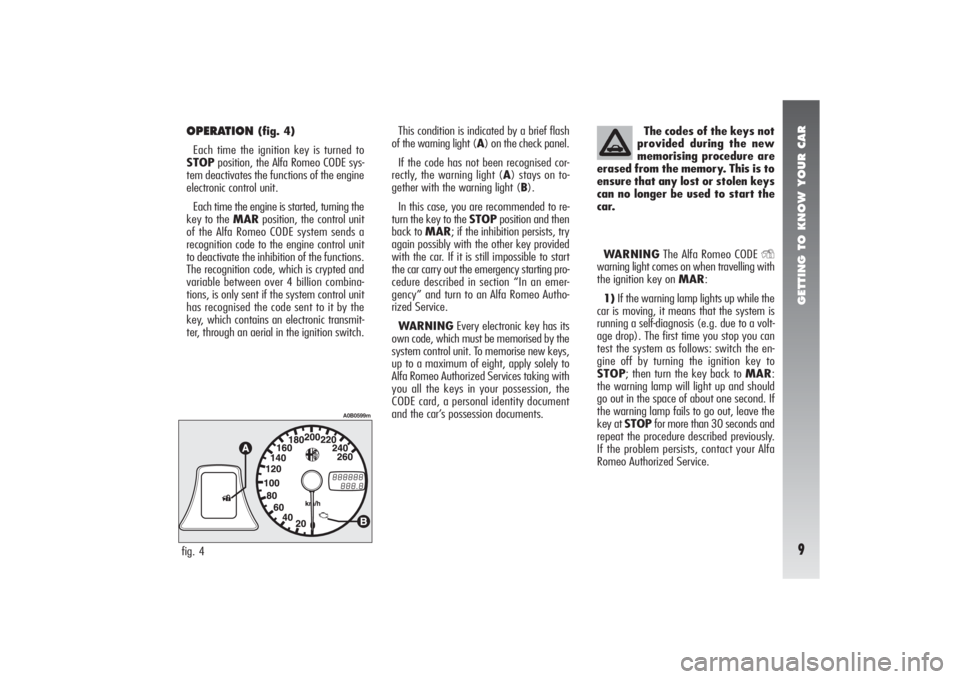
GETTING TO KNOW YOUR CAR9
OPERATION
(fig. 4)
Each time the ignition key is turned to
STOPposition, the Alfa Romeo CODE sys-
tem deactivates the functions of the engine
electronic control unit.
Each time the engine is started, turning the
key to the MARposition, the control unit
of the Alfa Romeo CODE system sends a
recognition code to the engine control unit
to deactivate the inhibition of the functions.
The recognition code, which is crypted and
variable between over 4 billion combina-
tions, is only sent if the system control unit
has recognised the code sent to it by the
key, which contains an electronic transmit-
ter, through an aerial in the ignition switch.This condition is indicated by a brief flash
of the warning light (A) on the check panel.
If the code has not been recognised cor-
rectly, the warning light (A) stays on to-
gether with the warning light (B).
In this case, you are recommended to re-
turn the key to the STOPposition and then
back to MAR; if the inhibition persists, try
again possibly with the other key provided
with the car. If it is still impossible to start
the car carry out the emergency starting pro-
cedure described in section “In an emer-
gency” and turn to an Alfa Romeo Autho-
rized Service.
WARNINGEvery electronic key has its
own code, which must be memorised by the
system control unit. To memorise new keys,
up to a maximum of eight, apply solely to
Alfa Romeo Authorized Services taking with
you all the keys in your possession, the
CODE card, a personal identity document
and the car’s possession documents.
fig. 4
A0B0599m
The codes of the keys not
provided during the new
memorising procedure are
erased from the memory. This is to
ensure that any lost or stolen keys
can no longer be used to start the
car.
WARNINGThe Alfa Romeo CODE
Y
warning light comes on when travelling with
the ignition key on MAR:
1)If the warning lamp lights up while the
car is moving, it means that the system is
running a self-diagnosis (e.g. due to a volt-
age drop). The first time you stop you can
test the system as follows: switch the en-
gine off by turning the ignition key to
STOP; then turn the key back to MAR:
the warning lamp will light up and should
go out in the space of about one second. If
the warning lamp fails to go out, leave the
key at STOPfor more than 30 seconds and
repeat the procedure described previously.
If the problem persists, contact your Alfa
Romeo Authorized Service.
Page 12 of 357
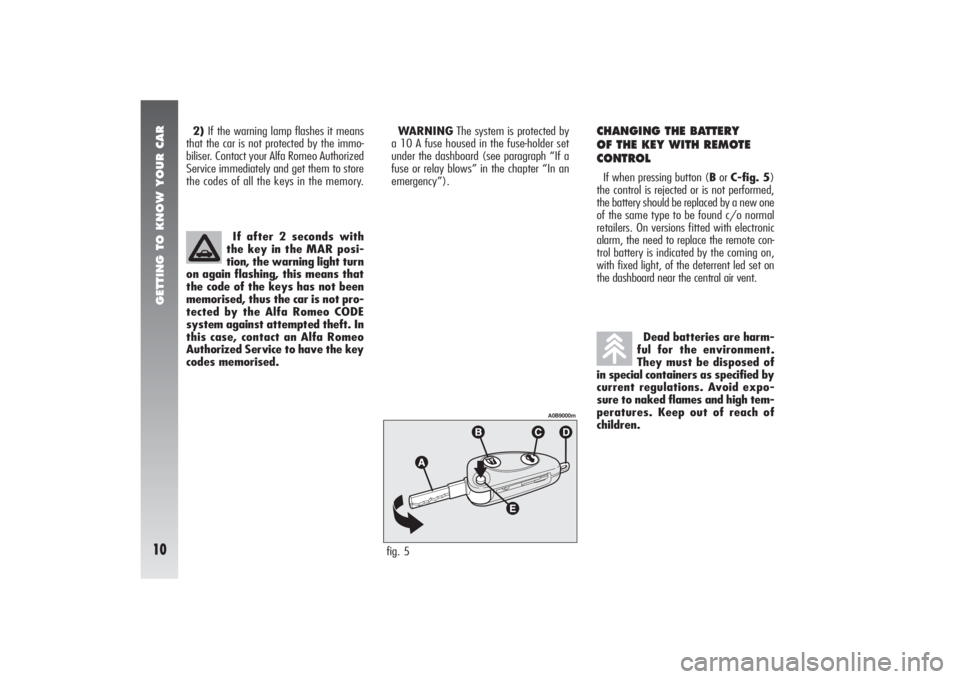
GETTING TO KNOW YOUR CAR10
2)If the warning lamp flashes it means
that the car is not protected by the immo-
biliser. Contact your Alfa Romeo Authorized
Service immediately and get them to store
the codes of all the keys in the memory.
CHANGING THE BATTERY
OF THE KEY WITH REMOTE
CONTROLIf when pressing button (Bor C-fig. 5)
the control is rejected or is not performed,
the battery should be replaced by a new one
of the same type to be found c/o normal
retailers. On versions fitted with electronic
alarm, the need to replace the remote con-
trol battery is indicated by the coming on,
with fixed light, of the deterrent led set on
the dashboard near the central air vent. If after 2 seconds with
the key in the MAR posi-
tion, the warning light turn
on again flashing, this means that
the code of the keys has not been
memorised, thus the car is not pro-
tected by the Alfa Romeo CODE
system against attempted theft. In
this case, contact an Alfa Romeo
Authorized Service to have the key
codes memorised.
Dead batteries are harm-
ful for the environment.
They must be disposed of
in special containers as specified by
current regulations. Avoid expo-
sure to naked flames and high tem-
peratures. Keep out of reach of
children.
fig. 5
A0B9000m
WARNINGThe system is protected by
a 10 A fuse housed in the fuse-holder set
under the dashboard (see paragraph “If a
fuse or relay blows” in the chapter “In an
emergency”).
Page 13 of 357
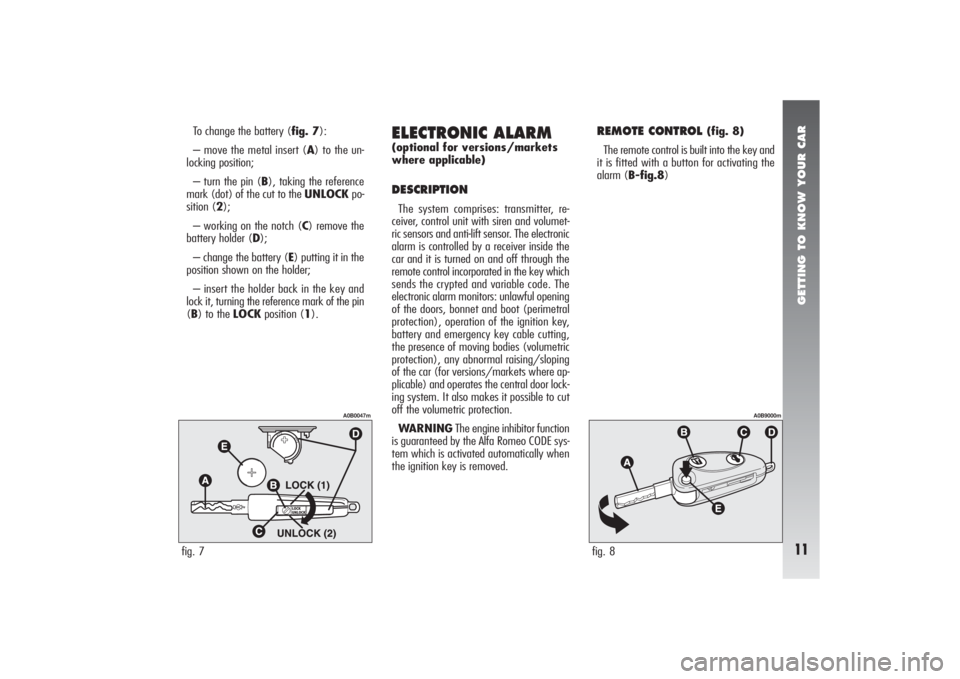
GETTING TO KNOW YOUR CAR11
To change the battery (fig. 7):
– move the metal insert (A) to the un-
locking position;
– turn the pin (B), taking the reference
mark (dot) of the cut to the UNLOCKpo-
sition (2);
– working on the notch (C) remove the
battery holder (D);
– change the battery (E) putting it in the
position shown on the holder;
– insert the holder back in the key and
lock it, turning the reference mark of the pin
(B) to the LOCKposition (1).
ELECTRONIC ALARM(optional for versions/markets
where applicable)DESCRIPTIONThe system comprises: transmitter, re-
ceiver, control unit with siren and volumet-
ric sensors and anti-lift sensor. The electronic
alarm is controlled by a receiver inside the
car and it is turned on and off through the
remote control incorporated in the key which
sends the crypted and variable code. The
electronic alarm monitors: unlawful opening
of the doors, bonnet and boot (perimetral
protection), operation of the ignition key,
battery and emergency key cable cutting,
the presence of moving bodies (volumetric
protection), any abnormal raising/sloping
of the car (for versions/markets where ap-
plicable) and operates the central door lock-
ing system. It also makes it possible to cut
off the volumetric protection.
WARNINGThe engine inhibitor function
is guaranteed by the Alfa Romeo CODE sys-
tem which is activated automatically when
the ignition key is removed.
fig. 7
A0B0047m
REMOTE CONTROL
(fig. 8)
The remote control is built into the key and
it is fitted with a button for activating the
alarm (B-fig.8)
fig. 8
A0B9000m
Page 14 of 357
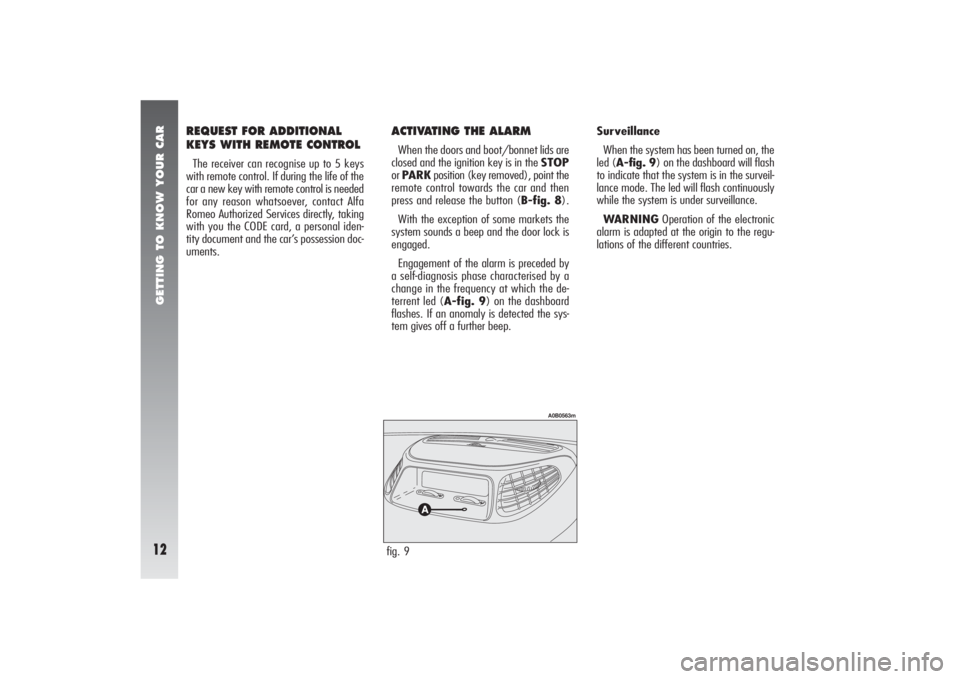
GETTING TO KNOW YOUR CAR12
REQUEST FOR ADDITIONAL
KEYS WITH REMOTE CONTROLThe receiver can recognise up to 5 keys
with remote control. If during the life of the
car a new key with remote control is needed
for any reason whatsoever, contact Alfa
Romeo Authorized Services directly, taking
with you the CODE card, a personal iden-
tity document and the car’s possession doc-
uments.
ACTIVATING THE ALARMWhen the doors and boot/bonnet lids are
closed and the ignition key is in the STOP
or PARKposition (key removed), point the
remote control towards the car and then
press and release the button (B-fig. 8).
With the exception of some markets the
system sounds a beep and the door lock is
engaged.
Engagement of the alarm is preceded by
a self-diagnosis phase characterised by a
change in the frequency at which the de-
terrent led (A-fig. 9) on the dashboard
flashes. If an anomaly is detected the sys-
tem gives off a further beep.fig. 9
A0B0563m
Surveillance
When the system has been turned on, the
led (A-fig. 9) on the dashboard will flash
to indicate that the system is in the surveil-
lance mode. The led will flash continuously
while the system is under surveillance.
WARNINGOperation of the electronic
alarm is adapted at the origin to the regu-
lations of the different countries.
Page 15 of 357
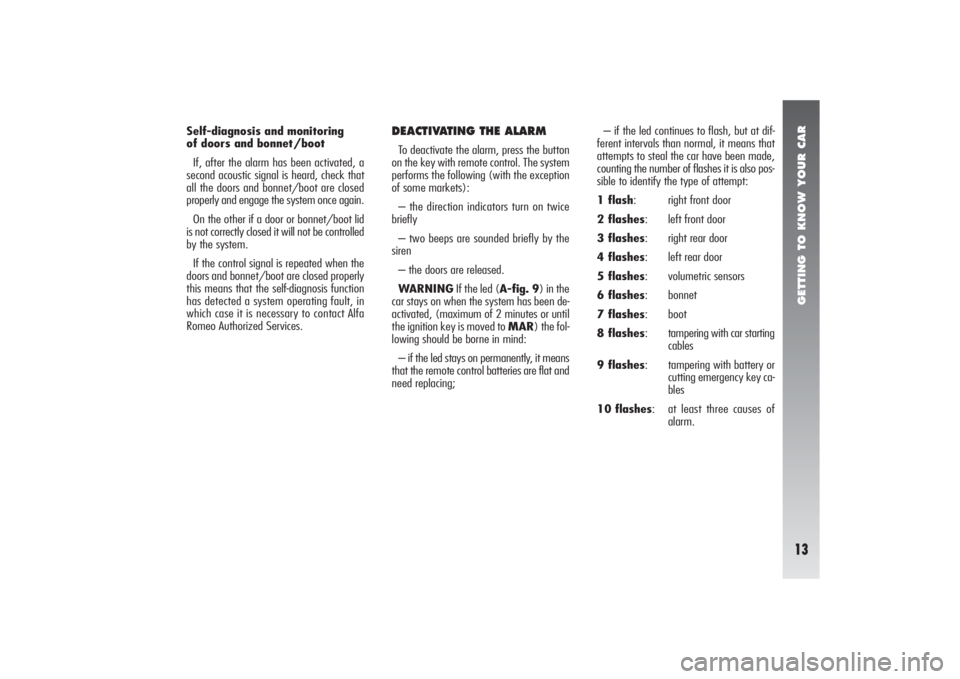
GETTING TO KNOW YOUR CAR13
Self-diagnosis and monitoring
of doors and bonnet/boot
If, after the alarm has been activated, a
second acoustic signal is heard, check that
all the doors and bonnet/boot are closed
properly and engage the system once again.
On the other if a door or bonnet/boot lid
is not correctly closed it will not be controlled
by the system.
If the control signal is repeated when the
doors and bonnet/boot are closed properly
this means that the self-diagnosis function
has detected a system operating fault, in
which case it is necessary to contact Alfa
Romeo Authorized Services.
DEACTIVATING THE ALARMTo deactivate the alarm, press the button
on the key with remote control. The system
performs the following (with the exception
of some markets):
– the direction indicators turn on twice
briefly
– two beeps are sounded briefly by the
siren
– the doors are released.
WARNINGIf the led (A-fig. 9) in the
car stays on when the system has been de-
activated, (maximum of 2 minutes or until
the ignition key is moved to MAR) the fol-
lowing should be borne in mind:
– if the led stays on permanently, it means
that the remote control batteries are flat and
need replacing;– if the led continues to flash, but at dif-
ferent intervals than normal, it means that
attempts to steal the car have been made,
counting the number of flashes it is also pos-
sible to identify the type of attempt:
1 flash: right front door
2 flashes: left front door
3 flashes: right rear door
4 flashes: left rear door
5 flashes: volumetric sensors
6 flashes: bonnet
7 flashes: boot
8 flashes: tampering with car starting
cables
9 flashes: tampering with battery or
cutting emergency key ca-
bles
10 flashes: at least three causes of
alarm.
Page 16 of 357
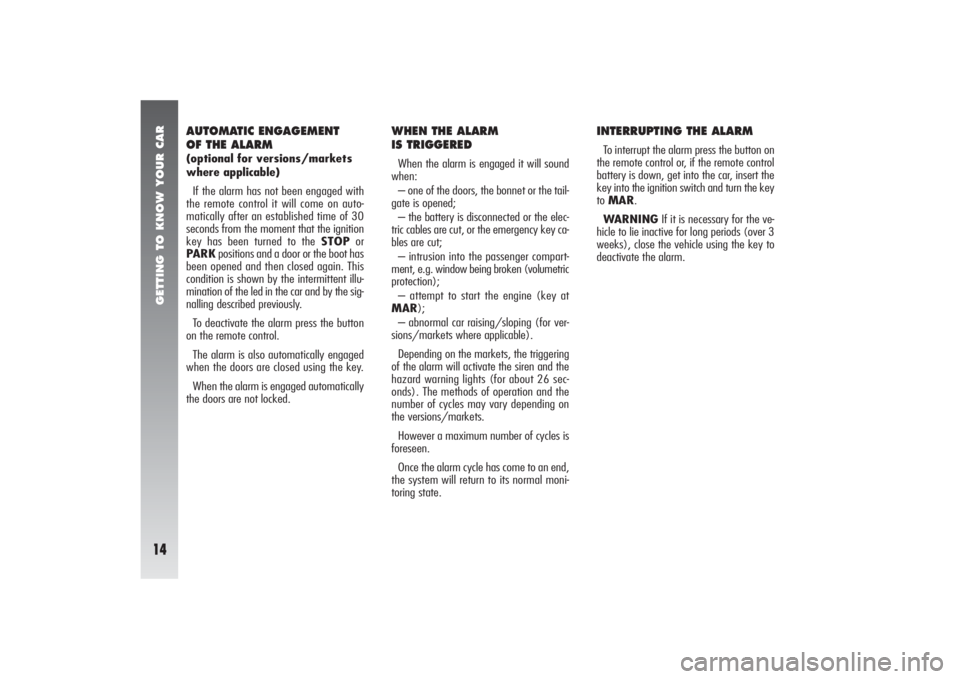
GETTING TO KNOW YOUR CAR14
AUTOMATIC ENGAGEMENT
OF THE ALARM (optional for versions/markets
where applicable)
If the alarm has not been engaged with
the remote control it will come on auto-
matically after an established time of 30
seconds from the moment that the ignition
key has been turned to the STOPor
PARKpositions and a door or the boot has
been opened and then closed again. This
condition is shown by the intermittent illu-
mination of the led in the car and by the sig-
nalling described previously.
To deactivate the alarm press the button
on the remote control.
The alarm is also automatically engaged
when the doors are closed using the key.
When the alarm is engaged automatically
the doors are not locked.
WHEN THE ALARM
IS TRIGGEREDWhen the alarm is engaged it will sound
when:
– one of the doors, the bonnet or the tail-
gate is opened;
– the battery is disconnected or the elec-
tric cables are cut, or the emergency key ca-
bles are cut;
– intrusion into the passenger compart-
ment, e.g. window being broken (volumetric
protection);
– attempt to start the engine (key at
MAR);
– abnormal car raising/sloping (for ver-
sions/markets where applicable).
Depending on the markets, the triggering
of the alarm will activate the siren and the
hazard warning lights (for about 26 sec-
onds). The methods of operation and the
number of cycles may vary depending on
the versions/markets.
However a maximum number of cycles is
foreseen.
Once the alarm cycle has come to an end,
the system will return to its normal moni-
toring state.
INTERRUPTING THE ALARMTo interrupt the alarm press the button on
the remote control or, if the remote control
battery is down, get into the car, insert the
key into the ignition switch and turn the key
to MAR.
WARNINGIf it is necessary for the ve-
hicle to lie inactive for long periods (over 3
weeks), close the vehicle using the key to
deactivate the alarm.
Page 17 of 357
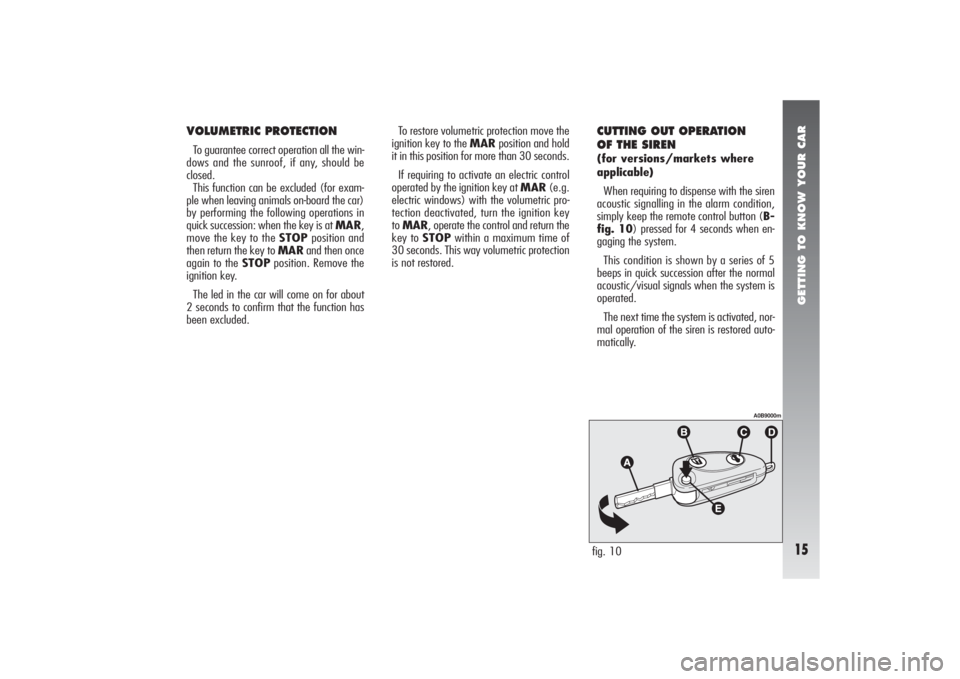
GETTING TO KNOW YOUR CAR15
VOLUMETRIC PROTECTIONTo guarantee correct operation all the win-
dows and the sunroof, if any, should be
closed.
This function can be excluded (for exam-
ple when leaving animals on-board the car)
by performing the following operations in
quick succession: when the key is at MAR,
move the key to the STOPposition and
then return the key to MARand then once
again to the STOPposition. Remove the
ignition key.
The led in the car will come on for about
2 seconds to confirm that the function has
been excluded.To restore volumetric protection move the
ignition key to the MARposition and hold
it in this position for more than 30 seconds.
If requiring to activate an electric control
operated by the ignition key at MAR(e.g.
electric windows) with the volumetric pro-
tection deactivated, turn the ignition key
to MAR, operate the control and return the
key to STOPwithin a maximum time of
30 seconds. This way volumetric protection
is not restored.
CUTTING OUT OPERATION
OF THE SIREN (for versions/markets where
applicable)
When requiring to dispense with the siren
acoustic signalling in the alarm condition,
simply keep the remote control button (B-
fig. 10) pressed for 4 seconds when en-
gaging the system.
This condition is shown by a series of 5
beeps in quick succession after the normal
acoustic/visual signals when the system is
operated.
The next time the system is activated, nor-
mal operation of the siren is restored auto-
matically.fig. 10
A0B9000m
Page 18 of 357
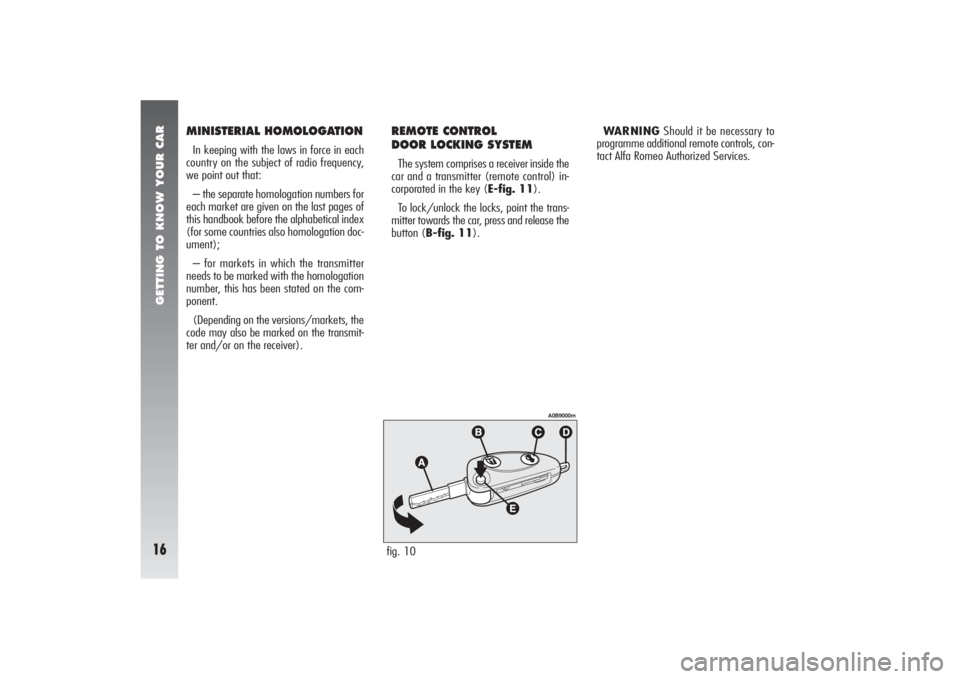
GETTING TO KNOW YOUR CAR16
MINISTERIAL HOMOLOGATIONIn keeping with the laws in force in each
country on the subject of radio frequency,
we point out that:
– the separate homologation numbers for
each market are given on the last pages of
this handbook before the alphabetical index
(for some countries also homologation doc-
ument);
– for markets in which the transmitter
needs to be marked with the homologation
number, this has been stated on the com-
ponent.
(Depending on the versions/markets, the
code may also be marked on the transmit-
ter and/or on the receiver).
REMOTE CONTROL
DOOR LOCKING SYSTEMThe system comprises a receiver inside the
car and a transmitter (remote control) in-
corporated in the key (E-fig. 11).
To lock/unlock the locks, point the trans-
mitter towards the car, press and release the
button (B-fig. 11).WARNINGShould it be necessary to
programme additional remote controls, con-
tact Alfa Romeo Authorized Services.fig. 10
A0B9000m
Page 19 of 357
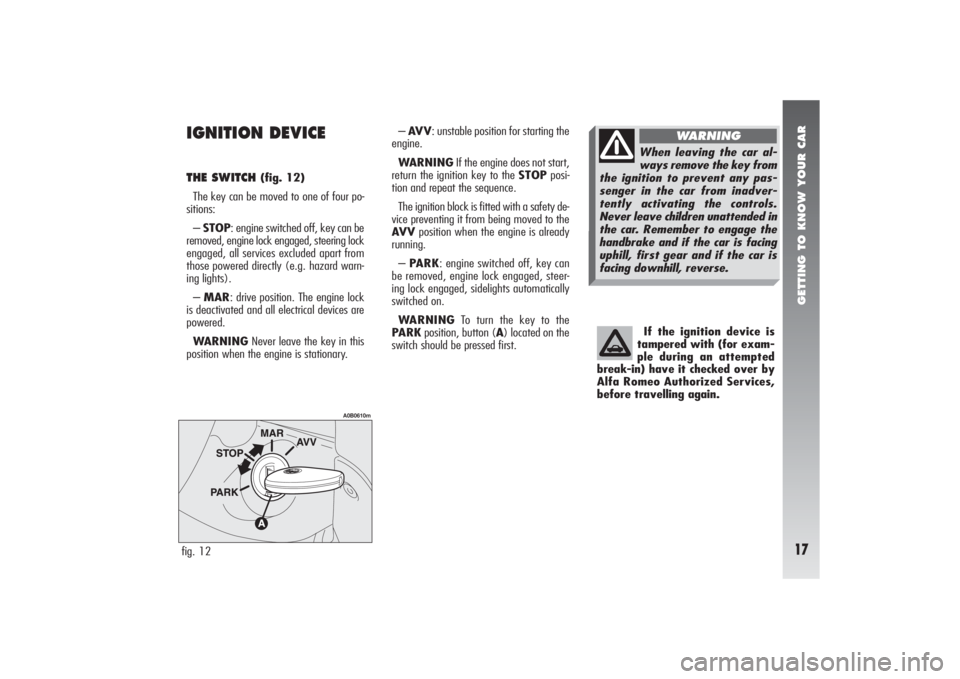
GETTING TO KNOW YOUR CAR17
IGNITION DEVICE THE SWITCH
(fig. 12)
The key can be moved to one of four po-
sitions:
– STOP: engine switched off, key can be
removed, engine lock engaged, steering lock
engaged, all services excluded apart from
those powered directly (e.g. hazard warn-
ing lights).
– MAR: drive position. The engine lock
is deactivated and all electrical devices are
powered.
WARNINGNever leave the key in this
position when the engine is stationary.– AV V: unstable position for starting the
engine.
WARNINGIf the engine does not start,
return the ignition key to the STOPposi-
tion and repeat the sequence.
The ignition block is fitted with a safety de-
vice preventing it from being moved to the
AV Vposition when the engine is already
running.
– PARK: engine switched off, key can
be removed, engine lock engaged, steer-
ing lock engaged, sidelights automatically
switched on.
WARNINGTo turn the key to the
PARKposition, button (A) located on the
switch should be pressed first.If the ignition device is
tampered with (for exam-
ple during an attempted
break-in) have it checked over by
Alfa Romeo Authorized Services,
before travelling again.
fig. 12
A0B0610m
When leaving the car al-
ways remove the key from
the ignition to prevent any pas-
senger in the car from inadver-
tently activating the controls.
Never leave children unattended in
the car. Remember to engage the
handbrake and if the car is facing
uphill, first gear and if the car is
facing downhill, reverse.
WARNING
Page 20 of 357
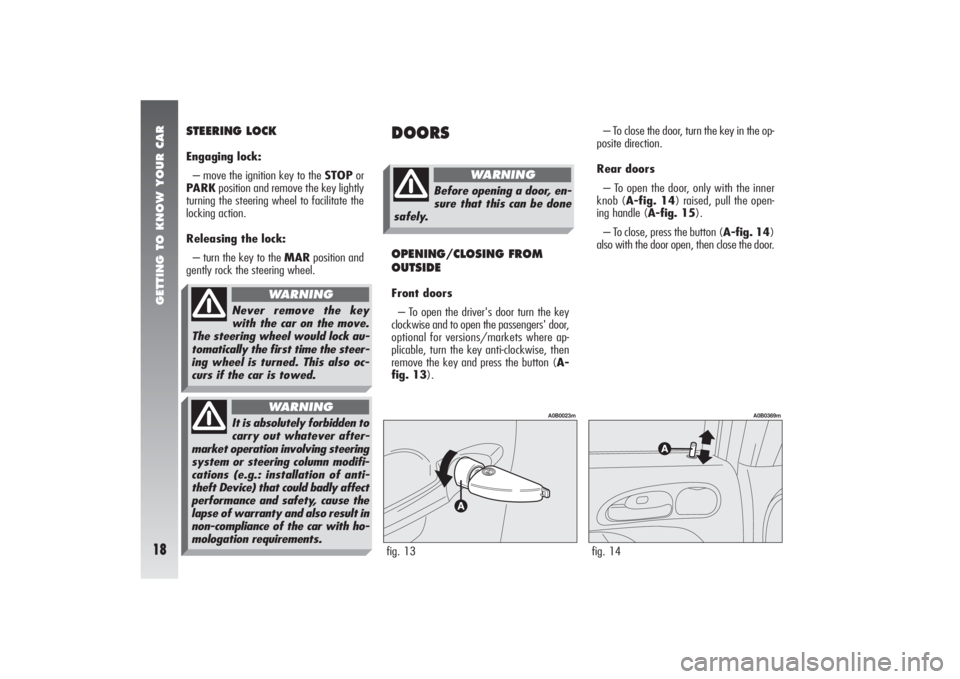
GETTING TO KNOW YOUR CAR18
STEERING LOCKEngaging lock:
– move the ignition key to the STOPor
PARKposition and remove the key lightly
turning the steering wheel to facilitate the
locking action.
Releasing the lock:
– turn the key to the MARposition and
gently rock the steering wheel.
DOORS
– To close the door, turn the key in the op-
posite direction.
Rear doors
– To open the door, only with the inner
knob (A-fig. 14) raised, pull the open-
ing handle (A-fig. 15).
– To close, press the button (A-fig. 14)
also with the door open, then close the door.
OPENING/CLOSING FROM
OUTSIDEFront doors
– To open the driver's door turn the key
clockwise and to open the passengers' door,
optional for versions/markets where ap-
plicable, turn the key anti-clockwise, then
remove the key and press the button (A-
fig. 13).fig. 13
A0B0023m
fig. 14
A0B0369m
Never remove the key
with the car on the move.
The steering wheel would lock au-
tomatically the first time the steer-
ing wheel is turned. This also oc-
curs if the car is towed.
WARNING
It is absolutely forbidden to
carry out whatever after-
market operation involving steering
system or steering column modifi-
cations (e.g.: installation of anti-
theft Device) that could badly affect
performance and safety, cause the
lapse of warranty and also result in
non-compliance of the car with ho-
mologation requirements.
WARNING
Before opening a door, en-
sure that this can be done
safely.
WARNING